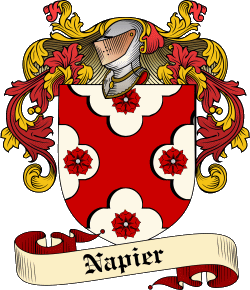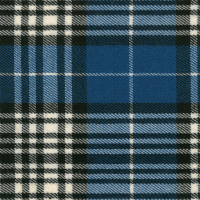Napier

Purchase Heraldry Products
Download Now!

Surname: Napier
Branch: Napier
Origins: Scottish
More Info: Scotland
|
|
Background: Napier derives originally from the English name given to the royal official of the nappery or linen although it is also a name of great antiquity in Scotland. Tradition says that the Napier family were descended from the ancient Earls of Lennox and it is in a charter of Malcolm, Earl of Lennox in 1280 that the first of the name is mentioned in Scotland; John de Napier held considerable estates in Dunbartonshire and later swore homage with Matthew le Napier de Aghelek to Edward I in 1296. John was also present in 1303 when Edward I besieged Stirling Castle assisting Sir William Oliphant in its defence and hence was fined severely for his patriotism. A descendant of his, William de Napier was governor of Edinburgh Castle in 1401 and his son, Alexander who obtained a charter of the lands and castle of Merchiston was provost of Edinburgh in 1437 and a successful wool merchant. His son Alexander was appointed comptroller, or financial administrator, to King James II in 1440 in virtue of the queen-mother, James's I widow Joan Beaufort. He had been wounded while helping to rescue her and her second husband, Sir James Stewart, the Black Knight of Lorne from the hands of the Livingstone faction who held them at Stirling. He was rewarded with the lands of Livingstone. John, the 3rd of Merchiston was killed at Sauchieburn in 1488, but through his marriage to. Elizabeth Menteith whose mother was Lady Margaret, second daughter of Duncan, Earl of Lennox, the family became allied to one of the first families of Scotland. His grandson, Alexander was killed at Flodden in 1513 and his own son, also Alexander was killed at Pinkie in 1547. His son Sir Archibald was knighted in 1567 and made Master of the Mint. His eldest son, John was the celebrated inventor of logarithms and was also an advanced agriculturalist. His son was a Lord of Session and was created Lord Napier of Merchiston in 1627. He was a loyal supporter of Charles I. He fought alongside Montrose at the Battle of Philiphaugh and escaped to Atholl where he died. His son also fought on the Royal side under his uncle the Marquis of Montrose but later died in exile on the continent. The 3rd Lord Napier was the last of the line and the title passed through his sister Margaret to her son Francis who became the 5th Lord Napier. His descendants became renowned for their outstanding military achievements. During the Napoleonic wars there were no less than five Napiers who became Generals.
|
 Motto: Motto: Sans tache, Without stain. Arms: Quarterly, 1st & 4th, Argent, a saltire engrailed cantoned of four roses Gules, barbed Vert (Napier); 2nd & 3rd, Or, on a bend Azure, a mullet pierced between two crescents of the Field, within a double tressure flory counterflory of the Second (Scott of Thirlestane); (below the shield) on a compartment, the top of an embattled tower Argent, masoned Sable, issuant therefrom six lances disposed saltirewise Proper, three and three, with pennons Azure (Scott). Crest: A dexter arm erect couped below the elbow Proper, grasping a crescent Argent. Supporters: Dexter, an eagle, wings expanded Proper; sinister, a chevalier in coat of mail and steel cap, all Proper, holding in the exterior hand a lance with a pennon Azure. View the Heraldry Dictionary for help.

The Napiers have a long and ancient history and are descended, through the Earls of Lennox, from the Celtic royal families of Scotland and Ireland. One suggested derivation of the name is from the officer of the royal household who was in charge of linen, the ‘naperer’. However, there is no evidence to suggest that this title was much used in Scotland, and a more stirring and poetic origin fo the name is offered. A knight of the Earl of Lennox, possibly a younger son, distinguished himself in battle during the reign of William the Lion. After the victory, the king singled out the young knight praising his valour which he said had ‘nae peer’. The earliest certain reference to the name appears in a charter of Malcolm, Earl of Lennox, sometime prior to 1290, which granted lands at Kilmahew in Dunbartonshire to John de Naper. The Napiers were to hold lands at Kilmahew for eighteen generations, until the estate was sold in 1820.
The first Laird of Merchiston, Alexander Napier, was a successful Edinburgh merchant who became Lord Provost of the city. In the practice of the time, he converted part of his wealth into land, obtaining a charter to the lands of Meriston in 1436. His son, Alexander Napier, later to be Lord Provost of Edinburgh also, rose high in royal favour. He was wounded while rescuing James I’s widow and her second husband, Sir James Stewart, from rebels who had captured them. James II honoured Napier by making him Comptroller of the Royal Household in 1440, and Vice Admiral of Scotland in 1461. His son, John, married Elizabeth Mentieth, great-granddaughter of Duncan, the last Celtic Earl of Lennox, who was executed with his sons by James I in 1424. John had a claim by marriage to the Lennox earldom but he did not pursue it. He died at the Battle of Sauchieburn in 1488. His heir, Alexander, and his grandson were both killed at Flodden in 1513, and the Battle of Pinkie in 1547 claimed another Napier heir.
The most famous of the name is the eighth Laird of Merchiston, John Napier, who developed the system of logarithms. His son, Archibald, who succeeded to Merchiston in 1617, accompanied James VI when he travelled to England to claim his new throne, and was sworn a Member of the Privy Council in 1615. He became a judge and was Lord Justice Clerk of Scotland from 1623 to 1624. He was first created a Baronet of Nova Scotia in 1627, and later in that year raised to the peerage as Baron Napier of Merchiston. He married Margaret, daughter of the fourth Earl of Montrose, and sister of the great Marquess. The brother-in-law of the king’s captain general could scarcely avoid the obligations of kinship, and Napiers supported the king throughout the civil war. Lord Napier died in 1645 and his only son, Archibald, second Baron Napier, was forced into exile when Scotland became part of the Commonwealth. He died in the Netherlands in 1660. Archibald, third Lord Napier, petitioned the Crown for a new patent to the barony, extending the succession to heirs female, including his sisters.The title passed to the only child of his eldest sister, Sir Thomas Nicholson of Carnock, and then to his aunt, Margaret Napier, wife of John Brisbane, Secretary to the Admiralty in the reign of Charles II. Baroness Napier was succeeded by her grandson, Francis Scott, who became the sixth Baron and adopted the name and arms of Napier.
Three grandsons of the sixth Lord Napier served throughout the Napoleonic Wars, each attaining the rank of general and the Order of the Bath. General Sir Charles conquered Sind in India, now part of Pakistan, and his statue can still be seen in Trafalgar Square, London. Francis, the eighth Lord, was an ensign when he was captured during the American War of Independence. He survived the ordeal, and later sat in Parliament as a representative Scottish peer, from 1796 to 1823. The ninth Lord was Chief Superintendent for Trade with China in 1833. He determined that Hong Kong should be annexed. His son, another Francis, became the tenth Lord Napier in 1834. A gifted academic, he received degrees from the Universities of Glasgow, Edinburgh and Harvard. He became a diplomat and was highly regarded in Washington prior to the outbreak of the American Civil War. He was a friend of Jefferson Davis, later to be the only president of the Confederate States of America. He was ambassador to the Netherlands, Russia and Prussia. He served as acting Viceroy of India in 1872. A Knight of the Thistle, he was created Baron Ettrick of Ettrick in the peerage of the United Kingdom in July 1872. On his return to Scotland he became chairman of the newly created Crofters Commission. The present chief, fourteenth Lord Napier and fifth of Ettrick, was Comptroller to the Household, and Private Secretary to the late Princess Margaret.
Name Variations: MacAlowne, Naiper, Napare, Napeir, Naper, Napier, Napper, Neaper, Nepare, Neper.
References:One or more of the following publications has been referenced for this article.The General Armory; Sir Bernard Burke - 1842.
A Handbook of Mottoes; C.N. Elvin - 1860.
Scottish Clans and Tartans; Neil Grant - 2000.
Scottish Clan and Family Encyclopedia; George Way of Plean and Romilly Squire - 1994.
Scottish Clans and Tartans; Ian Grimble - 1973.
World Tartans; Iain Zaczek - 2001.
Clans and Families of Scotland; Alexander Fulton - 1991.

|
|

The beautiful heraldry artwork for this family is available to purchase on select products from the Celtic Radio Store. We look forward to filling your order!

|
|

|

Modern |
|
|
|